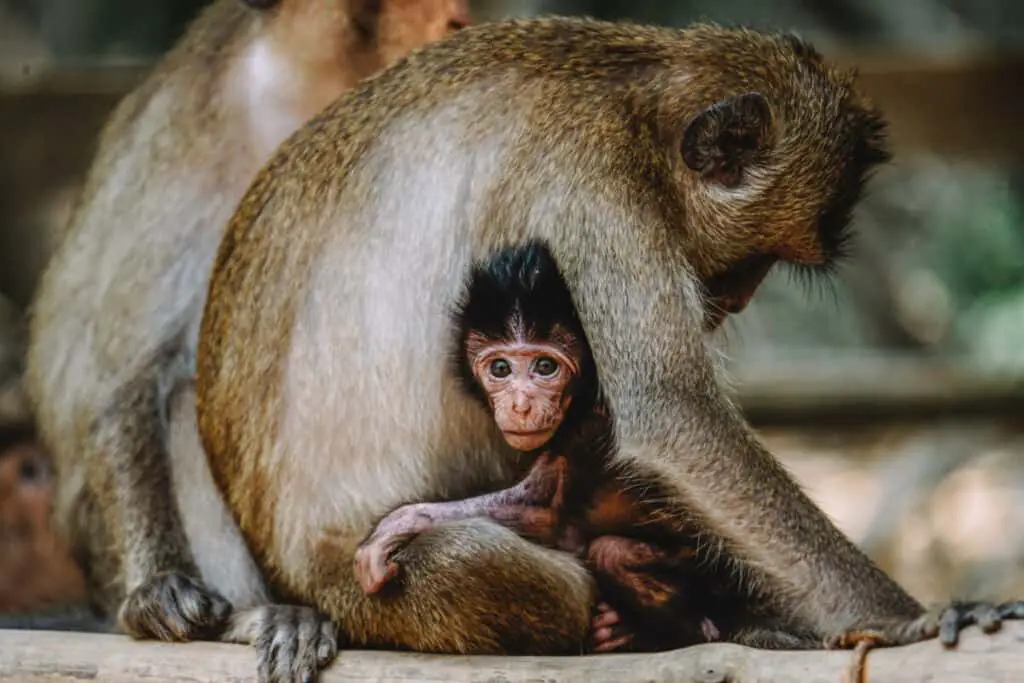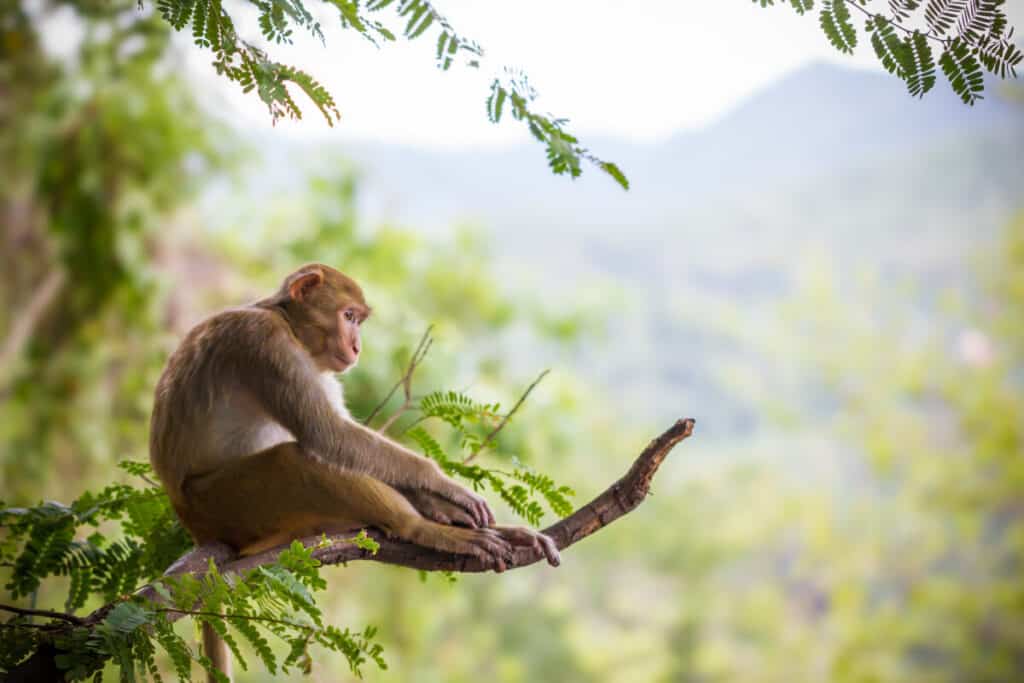The monkey is a fascinating creature that has captured the interest of researchers and enthusiasts alike. It belongs to the primate family, which includes apes as well as humans.
Monkeys are known for their intelligence, social behavior, and dexterity. There are over 260 species of monkeys in the world, each with unique physical and behavioral characteristics.
Some live in trees while others on the ground; some eat fruits while others prefer insects or even meat. Despite their differences, all monkeys share common traits such as their opposable thumbs and complex cognitive abilities.
These qualities have made them subjects of study across various fields from biology to psychology. This article provides an overview of these animals by examining their anatomy, habitat, behavior, and evolutionary history.

Anatomy Of A Monkey
Monkeys are some of the most fascinating creatures on Earth, with a wide range of skeletal features and digestive system adaptations that make them unique among primates.
The skeleton of a monkey is adapted for climbing trees and grasping branches, with long arms and legs, flexible joints, and strong muscles. Their hands have opposable thumbs which enable them to grasp objects tightly while their feet have a prehensile tail and they can easily cling onto trees.
In addition to their remarkable skeletal features, monkeys also possess highly specialized digestive systems that allow them to efficiently extract nutrients from tough plant materials. They have evolved elongated intestines that maximize nutrient absorption by providing more surface area for digestion.
Monkeys’ large caecum serves as an important site for bacterial fermentation in the gut to break down complex carbohydrates into simpler compounds such as glucose which can be absorbed through the intestinal wall. These adaptations represent just a few examples of how evolution has shaped the anatomy of monkeys over millions of years to enhance their survival in their natural habitats.
Red Leaf Monkeys’ Predators Revealed: Unmasking the Threats
Habitat And Distribution
The habitat and distribution of monkeys are dependent on the species. Some monkey species live in rainforests, while others occupy savannas, mountains, or even deserts.
The geographical range of these primates varies from continent to continent, with some being found only in specific regions such as Africa, Asia, South America, or Central America.
Unfortunately, several threats have put many monkey populations at risk. Habitat loss due to deforestation and human encroachment is a significant threat to their survival. Additionally, poaching for bushmeat and traditional medicine has led to declines in many primate populations worldwide.
To combat these threats and protect monkey populations, conservation efforts such as protected areas and sanctuaries have been established around the world. These measures aim to preserve habitats and prevent illegal hunting practices that could further endanger already vulnerable populations.
Mandrills’ Predators Exposed: Unmasking the Threats
Types Of Monkeys
Habitat and distribution play a significant role in understanding the lives of monkeys. These primates are found across different continents, including Asia, Africa, and South America.
The largest number of species can be found in Central and South America, where they occupy various habitats such as forests, savannas, and grasslands. Furthermore, some monkey species have adapted to living in urban areas due to deforestation and human encroachment on their natural habitats.
Spider monkeys are one of the most notable primate species from South America that live in trees high above the forest floor. They spend almost all their time up there; this is because they use their long arms and prehensile tail to navigate through tree branches with ease.
Macaques are another interesting type of monkey originating from Asia that exhibit unique social behavior. Unlike spider monkeys who tend to stay aloof from other members of their troop foraging alone or in small groups, macaques gather together in large troops ranging from 20-50 individuals.
Comparing these two types of monkeys reveals striking differences both physically and socially; however, each has evolved distinct survival strategies suited for its respective habitat environment.
Golden Lion Tamarins: Unmasking Their Predators
Social Behavior And Communication
Social Behavior and Communication are essential aspects of the monkey’s life.
Monkeys live in groups, which have a clear dominance hierarchy that determines their social structure. The higher-ranking individuals usually have access to better food sources, mating opportunities, and other resources than lower-ranking individuals. This ranking is established through various behaviors such as displays of aggression or submission.
Grooming behavior is another crucial aspect of the monkey’s social behavior. Grooming involves one monkey picking through the fur of another with its fingers or teeth, removing dirt and parasites while also building relationships between them. It helps strengthen bonds within the group by reducing tension and promoting trust among members. In some species, grooming can also be used as a form of currency where monkeys exchange it for food or other resources.
These behaviors allow monkeys to maintain complex social structures necessary for survival in their environment.
Cognitive Abilities And Intelligence
The theory that cognitive abilities and intelligence are uniquely human traits has been debunked by recent studies on primates, particularly monkeys. Research shows that certain species of monkeys possess problem-solving skills that were once thought to be exclusive to humans.
For instance, capuchin monkeys have been observed using tools such as sticks, stones, and even leaves to extract food from hard-to-reach places. Moreover, experiments conducted on rhesus macaques revealed their ability to perform complex tasks involving memory retention and retrieval.
In one study, the researchers taught the macaques how to play a computer game in which they had to remember the location of various icons on a screen. The results showed that the macaques could accurately recall these locations after several weeks of training. These findings challenge traditional notions about animal intelligence and suggest that primates may possess cognitive abilities similar to those found in humans.
Evolutionary History And Importance
Monkey evolution is a fascinating topic that has captured the interest of many researchers. These primates are believed to have evolved from a common ancestor with apes and humans around 25 million years ago.
The oldest known monkey fossils were found in Africa, suggesting that this was where they first originated. Over time, monkeys diversified into different species and spread out across the globe.
The ecological impact of monkeys cannot be overstated. They play an important role in maintaining the balance of ecosystems by dispersing seeds, pollinating plants, and controlling insect populations. In addition, their social behavior can also influence other animals within their habitat.
However, as human populations continue to grow and encroach on natural habitats, many monkey species are now facing threats such as loss of habitat and poaching for medicinal purposes or the pet trade. It is important to understand the evolutionary history of these creatures and work towards conserving them for future generations to appreciate their ecological importance.
Red Uakaris and Their Predators: Unmasking the Threats

Conclusion
Monkeys are fascinating creatures with a rich evolutionary history and complex social behavior. Their anatomy includes opposable thumbs, forward-facing eyes for depth perception, and prehensile tails in some species. They inhabit various environments around the world including rainforests, savannas, and mountains.
There are many types of monkeys, ranging from tiny pygmy marmosets to large mandrills. They exhibit intricate communication through vocalizations and body language within their social groups.
Studies have also shown that monkeys possess impressive cognitive abilities such as tool use and problem-solving skills. Overall, monkeys play an important role in our understanding of primate evolution and behavior.
As we continue to learn more about these intelligent animals, we gain insight into not only their own lives but also the complexities of our own human nature.
The rhetorical device used here is repetition – emphasizing the importance of studying monkeys by repeating phrases like ‘complex social behavior’ or ‘cognitive abilities.’
